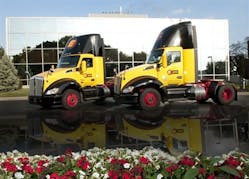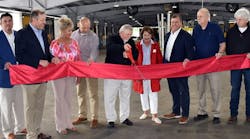William “Billy” Hupp will tell you that despite all the latest and greatest technologies now being deployed in the trucking business – everything from telematics to load dimensioning systems – many “old-school” business tactics continue to help motor carriers succeed in the ever-more challenging business of hauling freight.
“A lot of things are out of our control in this business; the only good thing is that our competition has the same challenges we do,” Hupp, COO and executive VP of LTL carrier Estes Express Lines, explained during a speech at the ALK Technology Summit in Philadelphia last week.
For example, he said the freight “costing process” in the LTL industry is increasingly becoming a “zero-sum game” where accuracy regarding the proffered price of a shipment “is critical” to helping motor carriers remain profitable.
“We use systems that calculate 72 different freight dimensions; in seven seconds or less we can calculate the cube and weight of a shipment with this technology,” he said. “That encourages us to get the ‘wrong’ shipments off our trucks.”
Yet Hupp was quick to note that despite the capabilities offered by such technologies, good solid “old school” principles are still needed to make them work effectively.
For example, Hupp told Fleet Owner that he got his start at Estes – a company founded by his grandfather, W.W. Estes, in 1931 – working in a maintenance shop with Robey “Rob” W. Estes Jr. who became the carrier’s president in 1987 and who remains in that position today.
“I’ve had one boss my entire life since we started working together in the shop as kids,” Hupp (at right) explained.He credits that “start at the bottom” work experience at Estes for keeping him grounded and willing to listen to ideas aimed at saving money or making money – or both – for the fleet.
For instance, a few years back, one of Estes’ older tractors – the fleet currently operates 6,819 power units and some 25,707 trailers – got damaged in a minor fender bender and needed a new hood. One of Estes’ technicians went online and found a perfect replacement for $1,500 – a replacement that turned out to be a hood from an Estes tractor the company has sold off.
As a result of that experience, Estes now operates two informal “chop shops” that convert older tractors destined to be cycled out of the fleet into either a ready supply replacement parts or ones that can be sold for good money.
“Engine blocks are particularly valuable,” Hupp said.
Finding positive ways to boost performance is another tactic Estes uses, sometimes with unexpected results, as Hupp’s son – a now working as a manager for Estes’ Norfolk, VA, terminal – found out.
In this case, he said the company wanted managers to reduce the number of “bring backs,” when freight must be returned to a terminal due to a missed delivery window or other reasons. Hupp noted his son decided to offer all the drivers at the Norfolk terminal free breakfast if they could reduce “bring backs.” They did one better: they completely eliminated them.
“They helped each other out, working as a team to make sure everyone’s freight got delivered for the day,” Hupp said. “My son said, ‘Wow this could get expensive for me,’ so we worked it over to a free breakfast once a week.”Fuel economy is another big focus at Estes and for good reason: its fleet burns an average of 82 million gallons of diesel per year. “At $2.50 a gallon, that’s a $250 million a year expense; but at $4 a gallon, it becomes a $328 million annual expense,” he pointed out.
Thus everything from the latest in aerodynamics – such as the use of trailer skirts – to the scoring of driver fuel performance metrics via telematics is deployed to reduce fuel consumption as much as possible.
And it’s working. Four years ago, Estes’ fleet averaged 6 mpg; today, that average is 7.1 mpg. “That 15% fuel economy improvement allows us to be more competitive,” Hupp explained.
Home-grown equipment specifications help, too, Hupp added, in order to boost the freight hauling efficiency of Estes’ trailers as high as possible.
“We’ve put a lot of time and effort into customizing our equipment, creating captive beam trailers built with ‘Webb walls’ to replace steel walls,” he said, “That allows us to create a second deck in the trailer, reduce trailer weight, and make it easier for forklifts to load and unload our trailers.”
That “home grown” mentality also applies to technology, as Hupp said that there are “few ‘off-the-shelf’ products” to support LTL operations.
“Technology is an arduous challenge; there’s a never ending need for it,” he explained. “We make large investments in IT [information technology] and we have to do it. And it’s made all the more challenging because of our inability to stop, rebuild a system, and start again.”
Yet marrying old-school business principles to the technology-heavy needs of freight seems to be paying off for Estes as it has gone from $100 million in revenue back in 1991 to topping $1 billion in 2004 to $2.28 billion last year.
“We remain family-owned and we plow a lot of that money back into the company,” Hupp stressed. “And LTL service is still our bread and butter, our ‘mother ship.’ It still pays the bills.”





